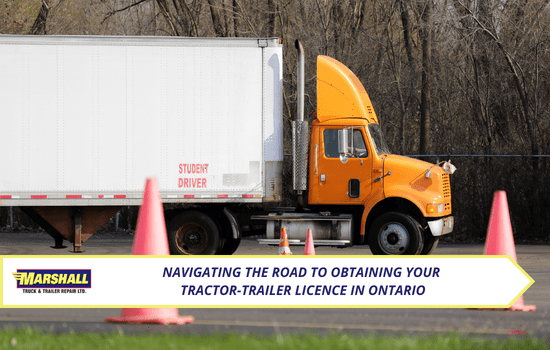Operating a tractor-trailer is a challenging and rewarding career path requiring specific skills and qualifications. In Ontario, Canada, obtaining a Class A truck licence involves a series of steps and requirements, that we’ve outlined for you.
A Comprehensive Guide to Getting Your Tractor Trailer Licence in Ontario
 In this blog post, we will guide you through the process of getting your Class A truck licence, from understanding the licensing requirements to successfully passing the examinations. So, let's hit the road and explore the journey of obtaining your tractor-trailer licence in Ontario.
In this blog post, we will guide you through the process of getting your Class A truck licence, from understanding the licensing requirements to successfully passing the examinations. So, let's hit the road and explore the journey of obtaining your tractor-trailer licence in Ontario.
Before we begin it is important you are aware of what is classified as a full Class A licence in Ontario. According to the Ontario Government’s website, “The full Class A truck licence is the only licence that covers full air brake systems on both tractors and trailers.” Our eight-step guide outlines what is required for this type of tractor-trailer licence.
Step 1: Obtain a G1 Licence
Before embarking on the journey of acquiring your tractor-trailer licence, you must first hold a valid G1 licence and be at least 18 years old. To obtain a G1 licence in Ontario, you need to pass a written knowledge test and a vision test. This licence allows you to operate a car, but you must be accompanied by a fully licenced driver with at least four years of driving experience.
Step 2: Gain Driving Experience
After obtaining your G1 licence, gaining sufficient driving experience is essential. Ontario's Graduated Licensing System (GLS) requires G1 drivers to practice driving for a minimum of 12 months before proceeding to the next stage. During this period, you should focus on building your driving skills and knowledge of traffic rules and regulations.
Step 3: Upgrade to G2 Licence
Once you have completed at least 12 months of practice with your G1 licence, you can take the road test to upgrade to a G2 licence. This stage allows you to drive independently with certain restrictions, such as a zero blood alcohol level and limiting the number of passengers in your vehicle.
Step 4: Enroll in a Truck Driving School
Enrolling in a reputable truck driving school is highly recommended to acquire the necessary skills and knowledge to operate a tractor-trailer. These schools provide comprehensive training programs that cover theoretical and practical aspects of driving a commercial vehicle.
At Marshall Truck & Trailer Repair we recommend both Ontario Truck Driving School (OTDS) and Modern Training Ontario. Be sure to research different schools, compare their offerings, and choose the one that best suits your needs.
Step 5: Pass the Written Knowledge Test
After completing your training at a truck driving school, you will need to pass the written knowledge test administered by the Ministry of Transportation Ontario. The test covers topics such as trucking regulations, safety procedures, vehicle inspection, and cargo handling.
Prepare thoroughly by studying the official driver's handbook and taking practice tests to increase your chances of success. Ontario's Official MTO Truck Handbook will help you prepare for your written knowledge test – read it online here.
Step 6: Obtain Your Medical Certificate
Commercial drivers are required to undergo a medical examination to ensure they are physically fit for the demands of the job. You can acquire a medical form from any DriveTest Centre in Ontario.
A medical report form can be completed by a physician or a nurse practitioner (RN-EC) licensed to practice medicine in Canada. Schedule an appointment with a certified medical examiner who will assess your overall health, vision, hearing, and other relevant factors. Obtain a Medical Report Form (MRF) from the examiner, which you will need to submit as part of your licence application.
Step 7: Practical Training and Road Test
With the theoretical knowledge and medical certificate in hand, it's time to undergo practical training with a qualified instructor. The instructor will guide you through the essential skills required for operating a tractor-trailer, including vehicle control, backing up, shifting gears, and maneuvering in various road conditions.
A mandatory entry-level training course must be successfully completed before attempting the Class A road test. As outlined on the Ontario Government website, “This training will include at least 103.5 hours of instruction and cover the entry-level knowledge and skills needed to safely operate a large truck on Ontario’s roads.” Once you are confident in your abilities, you can schedule the road test.
Step 8: Successfully Pass the Road Test
The final step in obtaining your tractor-trailer licence is the road test. The test evaluates your ability to handle the vehicle safely and effectively. It includes tasks such as driving in traffic, changing lanes, merging, making turns, daily vehicle inspection, and performing various maneuvers. Prepare thoroughly by practicing with a focus on precision and safety. Demonstrating confidence, proper vehicle control, and adherence to traffic rules will increase your chances of success.
Acquiring a tractor-trailer licence in Ontario, Canada, requires dedication, training, and a commitment to safety. Following the step-by-step process outlined in this blog can pave your way to a rewarding career as a professional truck driver.
